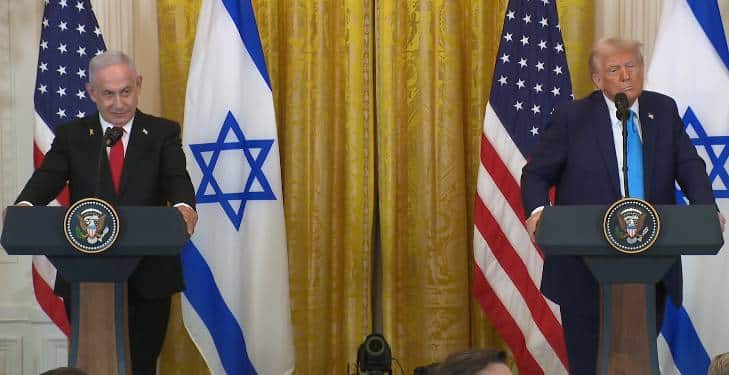Trump proposes U.S. takeover and reconstruction of Gaza Strip
During a White House press conference on February 4, 2025, U.S. President Donald Trump unveiled a groundbreaking proposal that could reshape the Middle East’s political landscape. Trump announced plans for the United States to take control of the Gaza Strip, a densely populated area that has faced decades of conflict and devastation. According to the president, the initiative would involve relocating the current Palestinian population to neighboring countries and completely rebuilding the region. The proposed efforts include clearing unexploded ordnance, demolishing destroyed buildings, and creating jobs and housing. Trump highlighted that this approach would serve as a definitive solution to longstanding security and stability issues, transforming Gaza into a model of economic development.
Trump emphasized that the relocation of Gaza’s inhabitants to nearby countries would be a permanent measure, arguing that keeping Palestinians in place would perpetuate the same issues seen over the past century. He suggested that removing the population would enable a more effective reconstruction effort, ensuring both security and stability. The president further stated that the United States would assume responsibility for removing remaining weaponry and reconstructing the infrastructure, laying the groundwork for a sustainable future.
The proposal, which has garnered support from Israeli Prime Minister Benjamin Netanyahu, marks a significant shift in U.S. foreign policy regarding the Israeli-Palestinian conflict. Although Trump did not present a specific timeline or detailed implementation plan, he indicated that the reconstruction would be led by the United States and could involve the presence of U.S. troops to ensure security and the project’s completion. According to Trump, this approach would usher in a new chapter in the international effort to stabilize the region and reduce the historical tensions between Israelis and Palestinians.
“The U.S. will take over the Gaza Strip, and we will do a job with it, too.” –President Donald J. Trump pic.twitter.com/aCqLl9Gwwn
— President Donald J. Trump (@POTUS) February 5, 2025
Historical context of the proposal
Trump’s vision for the Gaza Strip departs from the long-held objective of a two-state solution. For the past 70 years, the international community—led by the United States—has sought to negotiate peaceful coexistence between Israelis and Palestinians through numerous agreements and talks that often yielded limited results. The plan to permanently relocate Gaza’s population and rebuild the area under U.S. control represents a shift away from these diplomatic efforts, replacing them with direct intervention and structural reform.
Historically, the Gaza Strip has been a flashpoint of tension. From the creation of Israel in 1948 to Israel’s withdrawal from Gaza in 2005, the territory remained a focal point of conflict. Even after the Israeli withdrawal, Gaza endured cycles of violence, economic blockades, and dire humanitarian conditions. Trump’s proposal seeks to break this pattern, replacing the current model with an externally led redevelopment plan.
President Donald J. Trump Holds a Press Conference with Prime Minister @Netanyahu of Israel 🇺🇸🇮🇱 https://t.co/sXYoI4YYAH
— The White House (@WhiteHouse) February 4, 2025
The U.S. role in reconstruction
If enacted, Trump’s proposal would place the United States at the forefront of Gaza’s reconstruction—a role Washington has not directly taken in other Middle Eastern efforts. The U.S. would be responsible for removing leftover weapons, rebuilding basic infrastructure, and fostering a stable, secure environment for economic growth. This could also open up new opportunities for cooperation with regional partners, potentially reshaping relationships in the Middle East.
The relocation of Palestinians from Gaza lies at the heart of the plan. Trump contended that resettling Gaza’s residents in neighboring countries would eliminate the need for complex negotiations over sovereignty and political control of the territory. However, this approach raises concerns about humanitarian impact and legal implications, as the forced relocation of populations is controversial and faces strong opposition from international human rights organizations.
International and regional reactions
The proposal has elicited mixed responses both globally and regionally. Some Arab leaders have expressed skepticism about the feasibility of resettling Palestinians outside Gaza. Countries such as Egypt and Jordan have voiced resistance to absorbing large numbers of Gaza’s population, citing concerns over security, economic stability, and national sovereignty. Regional opposition could present a major hurdle, as the cooperation of neighboring nations would be essential for the relocation effort.
Human rights organizations have also criticized the proposal, warning that the forced relocation of Palestinians could constitute a violation of international law and be perceived as a form of ethnic cleansing. Humanitarian groups have cautioned against the risk of a deeper humanitarian crisis if the resettlement process is poorly planned or executed. The international community, including United Nations members, continues to monitor the proposal closely, raising questions about its legitimacy and long-term consequences.
Logistical and operational challenges
Implementing a plan of this scale presents numerous logistical and operational hurdles. Removing ordnance, clearing destroyed structures, building new infrastructure, and maintaining security in the territory would require a highly coordinated effort and significant investment. Additionally, direct U.S. oversight of Gaza raises questions about military presence and the duration of involvement—issues that could create tensions not only with Palestinians but also with other global powers invested in the region’s future.
Another major challenge is local resistance. Despite the difficult conditions in Gaza, many Palestinians consider the territory their rightful home and a symbol of their national struggle. Forced relocation would likely encounter opposition from the local population, complicating implementation. Moreover, the plan’s impact on Palestinian political leadership and their ability to negotiate on behalf of their people would be profound, directly influencing political dynamics between the Palestinian Authority and other regional actors.
Uncertainties and next steps
Despite the high-profile announcement, many details of Trump’s proposal remain unclear. There is no concrete timeline, no clear funding plan for reconstruction, no specifics on how the relocation would be carried out, and no guarantees that the process wouldn’t lead to further instability. Without clear answers to these questions, the proposal’s future remains uncertain, and its implementation will depend on complex negotiations with regional and international stakeholders.
The United States must demonstrate how it plans to maintain security during and after reconstruction, as well as the economic impact of such an undertaking. Furthermore, the role of the international community, humanitarian organizations, and the Palestinians themselves will be critical in determining whether Trump’s proposal is feasible or whether it will remain an ambitious but unrealistic attempt to address one of the modern world’s most enduring conflicts.

During a White House press conference on February 4, 2025, U.S. President Donald Trump unveiled a groundbreaking proposal that could reshape the Middle East’s political landscape. Trump announced plans for the United States to take control of the Gaza Strip, a densely populated area that has faced decades of conflict and devastation. According to the president, the initiative would involve relocating the current Palestinian population to neighboring countries and completely rebuilding the region. The proposed efforts include clearing unexploded ordnance, demolishing destroyed buildings, and creating jobs and housing. Trump highlighted that this approach would serve as a definitive solution to longstanding security and stability issues, transforming Gaza into a model of economic development.
Trump emphasized that the relocation of Gaza’s inhabitants to nearby countries would be a permanent measure, arguing that keeping Palestinians in place would perpetuate the same issues seen over the past century. He suggested that removing the population would enable a more effective reconstruction effort, ensuring both security and stability. The president further stated that the United States would assume responsibility for removing remaining weaponry and reconstructing the infrastructure, laying the groundwork for a sustainable future.
The proposal, which has garnered support from Israeli Prime Minister Benjamin Netanyahu, marks a significant shift in U.S. foreign policy regarding the Israeli-Palestinian conflict. Although Trump did not present a specific timeline or detailed implementation plan, he indicated that the reconstruction would be led by the United States and could involve the presence of U.S. troops to ensure security and the project’s completion. According to Trump, this approach would usher in a new chapter in the international effort to stabilize the region and reduce the historical tensions between Israelis and Palestinians.
“The U.S. will take over the Gaza Strip, and we will do a job with it, too.” –President Donald J. Trump pic.twitter.com/aCqLl9Gwwn
— President Donald J. Trump (@POTUS) February 5, 2025
Historical context of the proposal
Trump’s vision for the Gaza Strip departs from the long-held objective of a two-state solution. For the past 70 years, the international community—led by the United States—has sought to negotiate peaceful coexistence between Israelis and Palestinians through numerous agreements and talks that often yielded limited results. The plan to permanently relocate Gaza’s population and rebuild the area under U.S. control represents a shift away from these diplomatic efforts, replacing them with direct intervention and structural reform.
Historically, the Gaza Strip has been a flashpoint of tension. From the creation of Israel in 1948 to Israel’s withdrawal from Gaza in 2005, the territory remained a focal point of conflict. Even after the Israeli withdrawal, Gaza endured cycles of violence, economic blockades, and dire humanitarian conditions. Trump’s proposal seeks to break this pattern, replacing the current model with an externally led redevelopment plan.
President Donald J. Trump Holds a Press Conference with Prime Minister @Netanyahu of Israel 🇺🇸🇮🇱 https://t.co/sXYoI4YYAH
— The White House (@WhiteHouse) February 4, 2025
The U.S. role in reconstruction
If enacted, Trump’s proposal would place the United States at the forefront of Gaza’s reconstruction—a role Washington has not directly taken in other Middle Eastern efforts. The U.S. would be responsible for removing leftover weapons, rebuilding basic infrastructure, and fostering a stable, secure environment for economic growth. This could also open up new opportunities for cooperation with regional partners, potentially reshaping relationships in the Middle East.
The relocation of Palestinians from Gaza lies at the heart of the plan. Trump contended that resettling Gaza’s residents in neighboring countries would eliminate the need for complex negotiations over sovereignty and political control of the territory. However, this approach raises concerns about humanitarian impact and legal implications, as the forced relocation of populations is controversial and faces strong opposition from international human rights organizations.
International and regional reactions
The proposal has elicited mixed responses both globally and regionally. Some Arab leaders have expressed skepticism about the feasibility of resettling Palestinians outside Gaza. Countries such as Egypt and Jordan have voiced resistance to absorbing large numbers of Gaza’s population, citing concerns over security, economic stability, and national sovereignty. Regional opposition could present a major hurdle, as the cooperation of neighboring nations would be essential for the relocation effort.
Human rights organizations have also criticized the proposal, warning that the forced relocation of Palestinians could constitute a violation of international law and be perceived as a form of ethnic cleansing. Humanitarian groups have cautioned against the risk of a deeper humanitarian crisis if the resettlement process is poorly planned or executed. The international community, including United Nations members, continues to monitor the proposal closely, raising questions about its legitimacy and long-term consequences.
Logistical and operational challenges
Implementing a plan of this scale presents numerous logistical and operational hurdles. Removing ordnance, clearing destroyed structures, building new infrastructure, and maintaining security in the territory would require a highly coordinated effort and significant investment. Additionally, direct U.S. oversight of Gaza raises questions about military presence and the duration of involvement—issues that could create tensions not only with Palestinians but also with other global powers invested in the region’s future.
Another major challenge is local resistance. Despite the difficult conditions in Gaza, many Palestinians consider the territory their rightful home and a symbol of their national struggle. Forced relocation would likely encounter opposition from the local population, complicating implementation. Moreover, the plan’s impact on Palestinian political leadership and their ability to negotiate on behalf of their people would be profound, directly influencing political dynamics between the Palestinian Authority and other regional actors.
Uncertainties and next steps
Despite the high-profile announcement, many details of Trump’s proposal remain unclear. There is no concrete timeline, no clear funding plan for reconstruction, no specifics on how the relocation would be carried out, and no guarantees that the process wouldn’t lead to further instability. Without clear answers to these questions, the proposal’s future remains uncertain, and its implementation will depend on complex negotiations with regional and international stakeholders.
The United States must demonstrate how it plans to maintain security during and after reconstruction, as well as the economic impact of such an undertaking. Furthermore, the role of the international community, humanitarian organizations, and the Palestinians themselves will be critical in determining whether Trump’s proposal is feasible or whether it will remain an ambitious but unrealistic attempt to address one of the modern world’s most enduring conflicts.











Post Comment